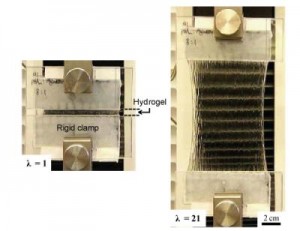A team from Harvard University have developed a technique for creating hydrogels that could be used effective in tissue engineering projects. From the Sept. 5, 2012 news release on EurekAlert,
A team of experts in mechanics, materials science, and tissue engineering at Harvard have created an extremely stretchy and tough gel that may pave the way to replacing damaged cartilage in human joints.
Called a hydrogel, because its main ingredient is water, the new material is a hybrid of two weak gels that combine to create something much stronger. Not only can this new gel stretch to 21 times its original length, but it is also exceptionally tough, self-healing, and biocompatible—a valuable collection of attributes that opens up new opportunities in medicine and tissue engineering.
Here’s an image of the hydrogel provided by the researchers,

The researchers pinned both ends of the new gel in clamps and stretched it to 21 times its initial length before it broke. Credit: Photo courtesy of Jeong-Yun Sun
The Sept. 5, 2012 news item on ScienceDaily has some comments from the researcher,
“Conventional hydrogels are very weak and brittle — imagine a spoon breaking through jelly,” explains lead author Jeong-Yun Sun, a postdoctoral fellow at the Harvard School of Engineering and Applied Sciences (SEAS). “But because they are water-based and biocompatible, people would like to use them for some very challenging applications like artificial cartilage or spinal disks. For a gel to work in those settings, it has to be able to stretch and expand under compression and tension without breaking.”
To create the tough new hydrogel, they combined two common polymers. The primary component is polyacrylamide, known for its use in soft contact lenses and as the electrophoresis gel that separates DNA fragments in biology labs; the second component is alginate, a seaweed extract that is frequently used to thicken food.
Separately, these gels are both quite weak — alginate, for instance, can stretch to only 1.2 times its length before it breaks. Combined in an 8:1 ratio, however, the two polymers form a complex network of crosslinked chains that reinforce one another. The chemical structure of this network allows the molecules to pull apart very slightly over a large area instead of allowing the gel to crack.
The alginate portion of the gel consists of polymer chains that form weak ionic bonds with one another, capturing calcium ions (added to the water) in the process. When the gel is stretched, some of these bonds between chains break — or “unzip,” as the researchers put it — releasing the calcium. As a result, the gel expands slightly, but the polymer chains themselves remain intact. Meanwhile, the polyacrylamide chains form a grid-like structure that bonds covalently (very tightly) with the alginate chains.
Therefore, if the gel acquires a tiny crack as it stretches, the polyacrylamide grid helps to spread the pulling force over a large area, tugging on the alginate’s ionic bonds and unzipping them here and there. The research team showed that even with a huge crack, a critically large hole, the hybrid gel can still stretch to 17 times its initial length.
Importantly, the new hydrogel is capable of maintaining its elasticity and toughness over multiple stretches.
Anyone can see that the ability to stretch, self-heal and stretch mimics the body’s own processes and that materials which can mimic those processes are very promising. From the news item on ScienceDaily,
Beyond artificial cartilage, the researchers suggest that the new hydrogel could be used in soft robotics, optics, artificial muscle, as a tough protective covering for wounds, or “any other place where we need hydrogels of high stretchability and high toughness.”
If you’re interested, there are still more details in the news release on EurekAlert or in the news item on ScienceDaily.